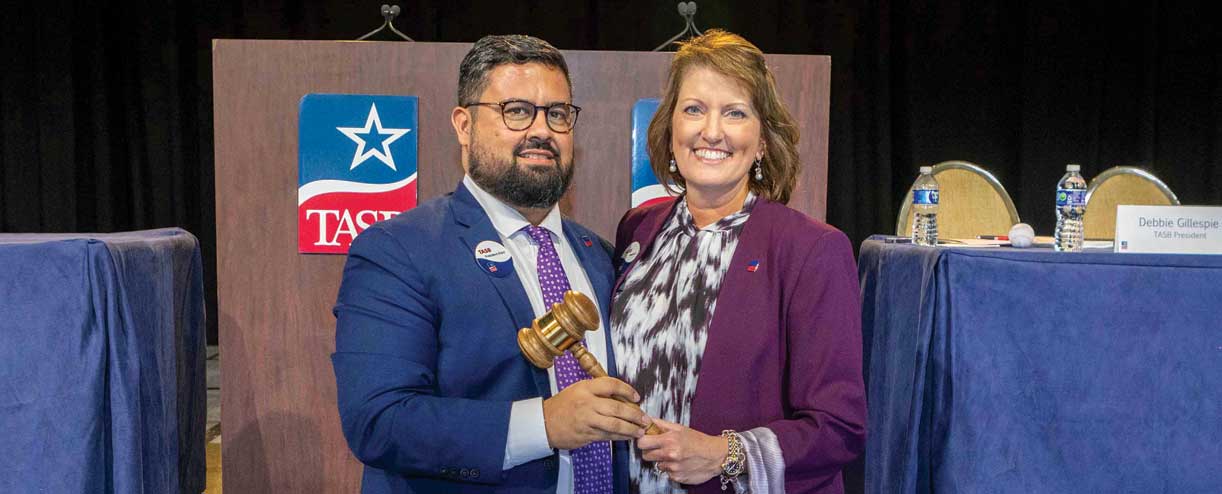Diplomacy and Conviction: Learning to Walk a Delicate Line with Advocacy
By Quintin Shepherd
In today’s educational and political landscape, governance is no longer about choosing between diplomacy and conviction. It is about learning to lead at the intersection of both. Although progress often requires a long-game mindset, ideals can be protected through pragmatic action.
Many educational leaders find themselves walking a delicate line. On one hand, they are committed to systems-level change rooted in fairness, opportunity, and innovation. On the other, they must navigate evolving political climates, imperfect legislation, and shifting public expectations. Leading in this moment calls for a reframing of what it means to be both diplomatic and resolute.

Pflugerville ISD Superintendent Quintin Shepherd chats with students at lunchtime.
Balancing Idealism and Pragmatism
Governing in education often involves supporting legislation that, while not perfect, reflects a step in the right direction. Current state legislative efforts in Texas may fall short in some areas of funding or implementation, yet they represent incremental progress. For education leaders, choosing to support these efforts is not an abandonment of higher aspirations, but rather a recognition that change, more often than not, is evolutionary rather than revolutionary.
This is not about settling. It is about strategic statesmanship, which is a governing philosophy that blends idealism with pragmatism. In this approach, advocacy becomes a process of engagement over time by laying the groundwork, building alliances, and shaping future amendments. It requires enduring participation in policymaking processes, even when outcomes are partial, delayed, or politically charged.
A Measured Approach
If you’ve ever heard me speak or read nearly anything I’ve ever written, you know I believe that in public service, the loudest voice is not always the most effective one. Measured leadership does not mean a lack of urgency or concern. Instead, it often means carrying the burden of urgency with deliberate care. When educators and students are under constant pressure, additional strain from reactive leadership can create more harm than good.
Superintendents and board members who advocate with intention often do so from a place of deep responsibility. Their aim is to protect students and staff from harmful policy, while not inadvertently increasing the operational burdens on those charged with implementing it. Thoughtful advocacy means making every move count — strategically, compassionately, and with eyes on the long term.
Creating Boundaries in Diplomacy
Diplomacy should not be confused with passivity. Drawing clear boundaries is not a retreat from engagement. It is often the foundation that enables productive dialogue. In governance, as in life, when boundaries are absent, erosion of trust, values, and, eventually, outcomes follows.
Knowing when to negotiate and when to hold the line is a skill set essential for today’s education leaders. It is possible to:
- Engage in diplomacy without being manipulated.
- Negotiate when it serves progress without compromising core convictions.
- Support incremental movement without accepting injustice as inevitable.
These principles require clarity of vision, patience, and the ability to communicate firm expectations even in the face of ambiguity.
Leading for the Long Game
Superintendents often carry the weight of advocacy with a sense of urgency, but also with caution. Every decision has the potential to ripple through communities, influence staff morale, and shape students’ experiences. The work is as emotional as it is operational.
Leading for the long game means understanding that progress in public education rarely arrives through sweeping reform. Instead, it comes through consistent engagement through activities such as testifying in hearings, collaborating across lines of difference, showing up for the difficult conversations, and cultivating the trust necessary to revisit decisions again and again as conditions evolve.
A New Model of Leadership
The public education landscape is changing. It demands a model of leadership that neither retreats to the middle nor rushes to the extremes. What is emerging is a new form, one that honors conviction but respects the necessary constraints of diplomacy. It asks leaders to draw boundaries that protect, not divide, and to build coalitions that can carry policy across the finish line, even if it takes more than one session to get there.
This leadership model is not about being the loudest voice or the quickest critic. It is about being persistent, strategic, and committed to transformation over time. In an era of polarization, the call to education leaders is not to choose between being idealists or realists, but to be both. To speak out not just with passion, but with purpose. Not just with urgency, but with endurance.
And most importantly, never confuse quiet leadership with passive leadership. Sometimes, the most transformative change begins not with a bang, but with a boundary.
Quintin Shepherd is the superintendent of Pflugerville ISD, located north of Austin and serving more than 23,000 students.
This article was originally published in the Texas Lone Star - August/September 2025 magazine.
Editor’s note: The District Voices column features opinion articles written by education leaders around Texas. Send submissions to managing editor Laura Tolley at laura.tolley@tasb.org.




